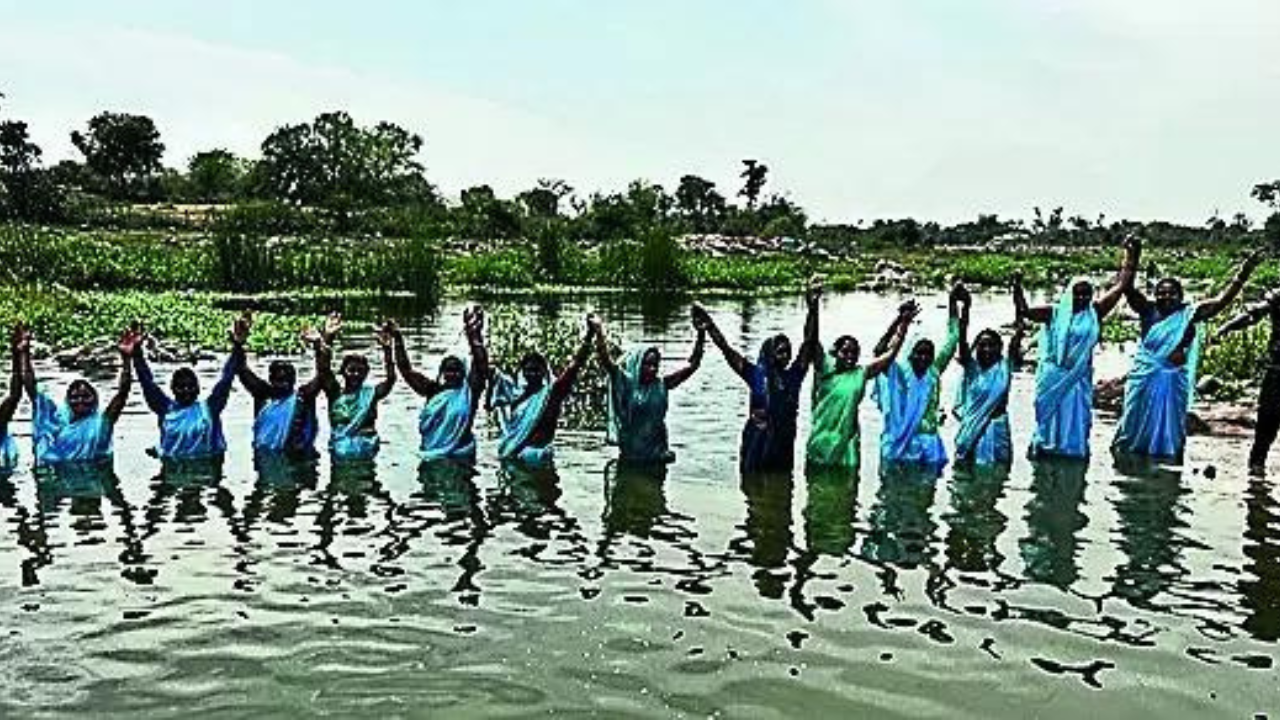BANDA/HAMIRPUR: Six of the seven districts in the poll-bound Bundelkhand region of UP, spread over four parliamentary constituencies, come in the top 100 riskiest districts in the country in terms of their vulnerability to climate change and future hazards, and this is reflected on the ground in depressed agricultural activitieswater scarcity and land degradation in all four Lok Sabha seats that will go to poll on Monday.
Out of 109 ‘very high risk’ districts in the country, 22 fall in UP and six of them – Hamirpur, Banda, Chitrakoot, Mahoba, Jalaun and Jhansi – are in the Bundelkhand region, according to the vulnerability assessment done by Indian Council of Agricultural Research. The list shows Hamirpur as the riskiest in UP followed by Banda. Nation-wide, Hamirpur is the ninth riskiest whereas Banda is at number 20 due to constant rise in minimum temperatures, extensive degraded land and high drought proneness.
The situation, that has affected farming operations, has already led to rural unemployment and migration. Though free ration and annual income support under PM-Kisan schemes are a help, farmers in the region desperately look for permanent irrigation facilities like what their counterparts in western UP have. Such facilities and other adaptation measures will help them face the challenges of climate change in future.
“We cannot survive without irrigation facilities. Underground water is depleting quite fast. We use diesel pump sets for irrigation. But the high price of diesel and high cost of deep boring make farming expensive,” said Ashok Singh of Banda tehsil. Other villagers have similar concerns, saying their district needs industries so that more and more people get jobs.
Though the Centre has approved the Ken-Betwa river linking project that will provide permanent irrigation facilities to 2.6 lakh hectares of land spread over Banda, Mahoba, Jhansi and Lalitpur districts of UP, it will take at least eight years for the project to get completed. The project envisages transfer of surplus water from Ken river to Betwa river through a 230-km concrete link canal.
“Betwa river is flowing through our district but we don’t get its benefit due to lack of irrigation canal network like what western Uttar Pradesh has. We hope to get such a network once the Ken-Betwa river link project is completed but all people will leave villages by then,” said Vinay Kumar Ahirwar of Nirni village in Hamirpur district.
Villagers in Lalitpur district of Jhansi parliamentary constituency have similar concerns. Jitendra Rajput of Kandhari Kalan village in Lalitpur district said, “Our village will also benefit from Ken-Betwa river link project, but no one knows when it will happen as nothing has been done so far on this project in my district.”
Meanwhile, farmers in his and other villages of the district are using diesel pump sets for irrigation. “It is quite expensive and villagers have to depend on local moneylenders to meet their farm input cost every season. Annual income support of Rs 6,000 under PM-Kisan scheme is, however, a big help,” said Rajput, who has five acres of land.
Out of 109 ‘very high risk’ districts in the country, 22 fall in UP and six of them – Hamirpur, Banda, Chitrakoot, Mahoba, Jalaun and Jhansi – are in the Bundelkhand region, according to the vulnerability assessment done by Indian Council of Agricultural Research. The list shows Hamirpur as the riskiest in UP followed by Banda. Nation-wide, Hamirpur is the ninth riskiest whereas Banda is at number 20 due to constant rise in minimum temperatures, extensive degraded land and high drought proneness.
The situation, that has affected farming operations, has already led to rural unemployment and migration. Though free ration and annual income support under PM-Kisan schemes are a help, farmers in the region desperately look for permanent irrigation facilities like what their counterparts in western UP have. Such facilities and other adaptation measures will help them face the challenges of climate change in future.
“We cannot survive without irrigation facilities. Underground water is depleting quite fast. We use diesel pump sets for irrigation. But the high price of diesel and high cost of deep boring make farming expensive,” said Ashok Singh of Banda tehsil. Other villagers have similar concerns, saying their district needs industries so that more and more people get jobs.
Though the Centre has approved the Ken-Betwa river linking project that will provide permanent irrigation facilities to 2.6 lakh hectares of land spread over Banda, Mahoba, Jhansi and Lalitpur districts of UP, it will take at least eight years for the project to get completed. The project envisages transfer of surplus water from Ken river to Betwa river through a 230-km concrete link canal.
“Betwa river is flowing through our district but we don’t get its benefit due to lack of irrigation canal network like what western Uttar Pradesh has. We hope to get such a network once the Ken-Betwa river link project is completed but all people will leave villages by then,” said Vinay Kumar Ahirwar of Nirni village in Hamirpur district.
Villagers in Lalitpur district of Jhansi parliamentary constituency have similar concerns. Jitendra Rajput of Kandhari Kalan village in Lalitpur district said, “Our village will also benefit from Ken-Betwa river link project, but no one knows when it will happen as nothing has been done so far on this project in my district.”
Meanwhile, farmers in his and other villages of the district are using diesel pump sets for irrigation. “It is quite expensive and villagers have to depend on local moneylenders to meet their farm input cost every season. Annual income support of Rs 6,000 under PM-Kisan scheme is, however, a big help,” said Rajput, who has five acres of land.






